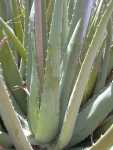Aloe
Scientific name:
Aloe barbadensis
Family: Aloeaceae
 Photo source: HEAR
Photo source: HEAR
Plant parts used
Leaves, rhizomes
Mode of action
Larvaticidal (Prakash; Rao, 1997: p. 17)
Formulations
| Materials |
Methods of preparation |
How to use |
Target pests |
Aloe, vitex extract
5 kg of vitex leaves
2 liters of aloe leaf juice
50-60 ml of soap
50 liters of water
Cooking pot
Pail |
n
Remove the outer part of the aloe leaves.
Grind to get the extract.
Strain.
Soak Vitex leaves in water.
Bring to boil for 30 minutes.
Cool and then strain.
|
Mix the two extracts.
Add 50 liters of water to the extract.
Stir in soap.
Spray on infested plants thoroughly.
Spray early in the morning or
late in the afternoon.
This formulation is good enough
to spray 0.4 ha area. |
Armyworm
Hairy leaf-caterpillar
Rice leaf roller
Rice stem borer
Semi-looper
Bacterial and fungal diseases
|
Aloe moth attractant
1/2 liter of aloe extract
1 kg of castor cake
Wide-opened containers
Plant latex or
resin |
Mix aloe and castor cake.
Add latex as an adhesive materials. |
Put mixture in wide open
containers.
Place the containers in strategic
locations in the field.
6 traps are good enough fo 1/2 ha.
|
Moths |
Standard procedures for the preparation and application of the plant extracts
- Select plant parts that are free from diseases.
- When storing the plant parts for future usage, make sure that they are properly dried and are stored in an airy container (never use plastic container), away from direct sunlight and moisture. Make sure that they are free from molds before using them.
- Use utensils for the extract preparation that are not use for your food preparation and for drinking and cooking
water containers. Clean properly all the utensils every time after using them.
- Make sure that you do not have direct contact with the crude extract while in the process of the preparation and during the application.
- Harvest all the mature and ripe fruits before plant extract application.
- Always test the plant extract formulation on a few infested plants first before going into large scale spraying. When adding soap as an emulsifier, use a potash-based one.
- Wear protective clothing while applying the extract.
- Wash your hands after handling the plant extract.
Effect on humans
Extra care should be taken while handling the plant latex because contact dermatitis can occur on sensitive individuals (NCSU, 1997).
Effect on non-target organisms
Aloe latex is harmful to animals (NCSU, 1997).

